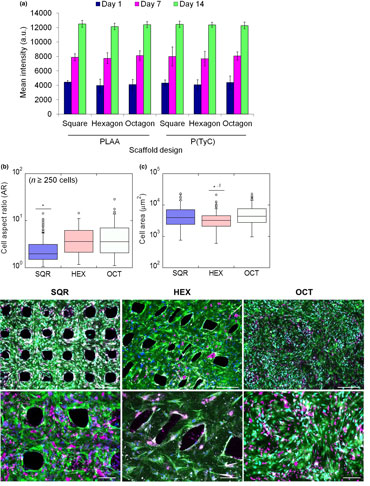Crossref Citations
This article has been cited by the following publications. This list is generated based on data provided by
Crossref.
Marklein, Ross A.
Lam, Johnny
Guvendiren, Murat
Sung, Kyung E.
and
Bauer, Steven R.
2018.
Functionally-Relevant Morphological Profiling: A Tool to Assess Cellular Heterogeneity.
Trends in Biotechnology,
Vol. 36,
Issue. 1,
p.
105.
Ji, Shen
and
Guvendiren, Murat
2019.
3D Printed Wavy Scaffolds Enhance Mesenchymal Stem Cell Osteogenesis.
Micromachines,
Vol. 11,
Issue. 1,
p.
31.
Tullii, Gabriele
Giona, Federica
Lodola, Francesco
Bonfadini, Silvio
Bossio, Caterina
Varo, Simone
Desii, Andrea
Criante, Luigino
Sala, Carlo
Pasini, Mariacecilia
Verpelli, Chiara
Galeotti, Francesco
and
Antognazza, Maria Rosa
2019.
High-Aspect-Ratio Semiconducting Polymer Pillars for 3D Cell Cultures.
ACS Applied Materials & Interfaces,
Vol. 11,
Issue. 31,
p.
28125.
Jayasinghe, Hasani G.
Madihally, Sundararajan V.
and
Vasquez, Yolanda
2019.
Formation of Stem Cell Aggregates and Their Differentiation on Surface-Patterned Hydrogels Based on Poly(2-hydroxyethyl Methacrylate).
ACS Applied Bio Materials,
Vol. 2,
Issue. 11,
p.
4911.
Highley, Christopher B.
2019.
3D Bioprinting in Medicine.
p.
1.
Xu, Junpeng
Wong, Chui-Wei
and
Hsu, Shan-hui
2020.
An Injectable, Electroconductive Hydrogel/Scaffold for Neural Repair and Motion Sensing.
Chemistry of Materials,
Vol. 32,
Issue. 24,
p.
10407.
Man, Kenny
Brunet, Mathieu Y.
Louth, Sophie
Robinson, Thomas E.
Fernandez-Rhodes, Maria
Williams, Soraya
Federici, Angelica S.
Davies, Owen G.
Hoey, David A.
and
Cox, Sophie C.
2021.
Development of a Bone-Mimetic 3D Printed Ti6Al4V Scaffold to Enhance Osteoblast-Derived Extracellular Vesicles’ Therapeutic Efficacy for Bone Regeneration.
Frontiers in Bioengineering and Biotechnology,
Vol. 9,
Issue. ,
Han, Weijing
El Botty, Rania
Montaudon, Elodie
Malaquin, Laurent
Deschaseaux, Frederic
Espagnolle, Nicolas
Marangoni, Elisabetta
Cottu, Paul
Zalcman, Gérard
Parrini, Maria Carla
Assayag, Franck
Sensebe, Luc
Silberzan, Pascal
Vincent-Salomon, Anne
Dutertre, Guillaume
Roman-Roman, Sergio
Descroix, Stephanie
and
Camonis, Jacques
2021.
In vitro bone metastasis dwelling in a 3D bioengineered niche.
Biomaterials,
Vol. 269,
Issue. ,
p.
120624.
Chiesa, Irene
De Maria, Carmelo
Ceccarini, Maria Rachele
Mussolin, Lorenzo
Coletta, Riccardo
Morabito, Antonino
Tonin, Rodolfo
Calamai, Martino
Morrone, Amelia
Beccari, Tommaso
and
Valentini, Luca
2022.
3D Printing Silk-Based Bioresorbable Piezoelectric Self-Adhesive Holey Structures for In Vivo Monitoring on Soft Tissues.
ACS Applied Materials & Interfaces,
Vol. 14,
Issue. 17,
p.
19253.
Lai, Huinan
Gong, Bo
Yin, Jun
and
Qian, Jin
2022.
3D printing topographic cues for cell contact guidance: A review.
Materials & Design,
Vol. 218,
Issue. ,
p.
110663.
Nuge, Tamrin
Liu, Xiaoling
Tshai, Kim Yeow
Lim, Siew Shee
Nordin, Norshariza
Hoque, Md. Enamul
and
Liu, Ziqian
2022.
Accelerated wound closure: Systematic evaluation of cellulose acetate effects on biologically active molecules release from amniotic fluid stem cells.
Biotechnology and Applied Biochemistry,
Vol. 69,
Issue. 3,
p.
906.
Huang, Xueying
Zeng, Jie
and
Wang, Yi
2023.
Comparison of the enhanced attachment and proliferation of the human mesenchymal stem cells on the biomimetic nanopatterned surfaces of zein, silk fibroin, and gelatin.
Journal of Biomedical Materials Research Part B: Applied Biomaterials,
Vol. 111,
Issue. 1,
p.
161.
Papadimitriou, Lina
Karagiannaki, Anna
Stratakis, Emmanuel
and
Ranella, Anthi
2024.
Substrate topography affects PC12 cell differentiation through mechanotransduction mechanisms.
Mechanobiology in Medicine ,
Vol. 2,
Issue. 1,
p.
100039.
Jiang, Huamin
Lin, Zhaoyi
Li, Jinze
Song, Ting
Zang, Hongyun
Li, Pengwen
Li, Jiarun
Hou, Wenyi
Zhou, Jianhua
and
Li, Yan
2024.
rADSC-loaded tubular units composed of multilayer electrospun membranes promoted bone regeneration of critical-sized skull defects.
Materials Futures,
Vol. 3,
Issue. 3,
p.
035403.
Sebastiani, Sara
Buccino, Federica
Qin, Zhao
and
Vergani, Laura Maria
2025.
Structural influences on bone tissue engineering: A review and perspective.
Matter,
Vol. 8,
Issue. 9,
p.
102252.
Islam, Md Shariful
Molley, Thomas G.
Jalandhra, Gagan K.
Fang, Jason
Kruzic, Jamie J.
and
Kilian, Kristopher A.
2025.
Magnetoactive Nanotopography on Hydrogels for Stimulated Cell Adhesion and Differentiation.
Small Science,
Vol. 5,
Issue. 4,


